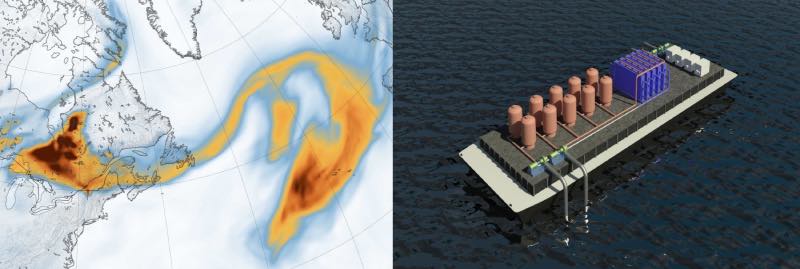God showed Noah by the rainbow sign,
no more water, but fire next time.
Fire Next Time Lyrics by Rev. Milton Brunson
Wildfires produce ozone, sulfur dioxide, nitrogen dioxide, carbon monoxide, volatile organic compounds, volatile heavy metals, and fine particulate matter (PM 2.5), made of toxic byproducts of combustion, which penetrate deep into the lungs, and into the bloodstream, with serious consequences. Two-point-five-micron particles are not visible to the naked eye; when present in high concentration they act like a clouded lens, producing the brown haze we have seen over New York and Chicago. They will persist in the atmosphere for weeks. (reference: Wildfire smoke 101: Wildfire smoke and your health )
Forest fires grow in phases. Ignition is most often caused by lightning, then human error, and lastly arson. If the weather has been cold and damp, when lightning strikes deep in the forest, a tree might split and wet ground cover will scorch, but nothing more.
However, if it is hot, windy, and dry, lightning will set trees on fire, and the leaves and branches on the forest floor will spread it. The dry bark of many trees ignites, and the fire climbs vertically. The bark of the firs, spruce, and pines that cover the Canadian forest have been baked dry, and in the heat of a forest fire — as much as 2000 degrees — these tree trunks explode. The fire climbs the trees and breaks through the forest “crown,” where embers fly and start more fires for miles downwind. A crown fire will jump roads, fields, and fire breaks.
Large fires create their own weather. Many columns of the fire coalesce, shooting embers, ash, and steam thousands of feet into the air. Air rushes in from all points of the compass replacing the hot air going vertical. The hot ash rises thousands of feet. If the column of fire rotates, it can form a “fire tornado” with winds as high as 140 miles an hour. The tornado generates lightning, rips apart the structures it doesn’t burn, and moves forty miles per hour. The fire tornado in the wildfire in Carr, California rose eighteen thousand feet and leveled everything in its path.
The firebombing of Tokyo in 1945, a city composed of wooden structures, resulted in the largest firestorm in history. The survivors were inundated with wet dark ash, and to this day it is known as “The Night of the Black Rain,” not the night of a great fire. One hundred thousand people died, more than in the atomic bombing of Hiroshima and Nagasaki combined.
Is This the Fire Next Time?
Is it a coincidence that the warmest May in Canadian history preceded the most intense wildfire season on record? In Ontario, the fires were receding when they were reignited by a temperature inversion, not a match, not lightning or human error. The southerly flow of smoke brought toxic clouds to New York, Chicago, and the Midwest. This fire zone in Ontario is the size of New England. It will burn for a hundred more days.
Trees capture carbon. Arboreal respiration is trees absorbing CO2 and producing oxygen. Trees are built of carbon. When they burn, the carbon reenters the atmosphere — by the ton. A forest fire removes an agent of carbon capture that took a century to grow, and in days deposits hundreds of tons of carbon back into the atmosphere. The Canadian fires will continue to burn. That much smoke could accelerate climate change.
Climate deniers say the earth is in a natural warming cycle between Ice Ages. Predicting climate has always been an iffy game. In their favor, one should never bet against Mother Nature changing the climate. A series of volcanic eruptions in Indonesia starting in 1810 culminated in 1815, when the Tambora volcano erupted, throwing fifty times more material into the air than the St. Helens eruption. The dust blotted out the sun, beginning an Ice Age. In July of 1816, there were famines in China for years after, and snowstorms in Paris in July.
The Ice Age hypothesis is convenient because no one was there to witness it. But the archaeological record does not contain anything that resembles our current tipping point.
The world is getting warmer. Perhaps because we are in a warming cycle between Ice Ages. But if we are approaching a tipping point because of the rapid accumulation of CO2 from burning fossil fuels, we will see an acceleration of ice caps melting, Antarctic shelf collapses, disappearances of species, epidemics where they don’t belong, droughts, and floods. This particular confluence of events has not been seen in the Ice Age cycle. It will be time for everyone on both sides of the argument to fix whatever can get fixed.
What to do?
On the fixing side, thirty-percent of all the carbon on the earth is in the ocean. If one removes carbon from the ocean, the ocean will remove from the air to replace what it lost. The Massachusetts Institute of Technology has already designed a floating carbon capture factory. It is cheap and efficient. The same equipment could be installed on cargo ships and desalinization plants. The removed carbon can be used in animal feed, industrial uses, or deposited in deep geologic formations. These floating carbon capture factories could scour the planet as they travel on the oceans. The appeal of this device is that it can be scaled up to an enormous size, and it consumes very little energy.
Read more here: How to pull carbon dioxide out of seawater
© Author: James Edward Katz, MD

